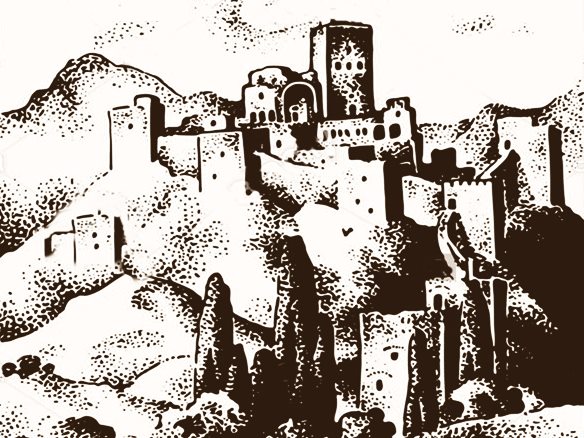
Siege of Auximus |
year: 539Apr-Nov 539 |
| Sige and capture of Auximus (Osimo) by Belisarius | ★ ★ ★ ★ ★ |
|
enemy: Ostrogoths
|
location: Auximus, present-day Osimo in Italy
|
accuracy:
●●●●●
|
|
battle type: Siege |
war: Gothic War in Italy |
modern country:
Italy |
| ▼ The Byzantines(emperor: Justinian I) | ▼ The Enemies | |
| Commander: | General Belisarius | Unknown |
| Forces: | 11,000 | 10,000 |
| Losses: |
| Background story: |
| After the end of the siege of Rome by the Ostrogoths in the spring of 538, Belisarius gained the initiative in the war against the Goths. The overall strategic objective was Ravenna, the seat of the Ostrogothic king Vitiges. But before the Romans could get there, the inland Gothic strongholds had to be taken. Belisarius was advancing slowly and methodically, constantly gaining ground, although in March 539 he had a serious setback, when the Ostrogoths under Uraias, assisted by 10,000 Burgundians, sacked and razed the Byzantine-held city of Milan. Despite this, operations continued in central Italy. Belisarius estimated that the main obstacle to Ravenna was the city and strong fortress Auximus (or Auximum, today Osimo) located in a strategic position on the Via Flaminia. Belisarius did not want to bypass Auximus and continue further north, having this important castle in his rear. King Vitiges himself estimated that Auximus was of great importance for his defense and had manned the garrison with many elite warriors who gradually reached 10,000. Shortly before the siege of the city began, Belisarius had sent an army led by Martinos and John, along with another John, the Gluton, to block Uraias north of the Po river. He had also sent an army under Cyprian and Justin to besiege the town of Fiesole, near Florence, which was monitoring an alternative route to Ravenna. At this stage of the Gothic War, and after the serious failure in Milan, Narses had already been recalled to Constantinople and Belisarius was again the undisputed leader of the campaign in Italy. |
The Battle: |
 The hostilities started from the first day. Upon his arrival, Belisarius had ordered the camp to be set up in a circular formation around the city. The Goths, seeing from the walls the enemies relaxed and scattered, engaged in setting up tents, and the various units at a great distance from each other, decided to take them by surprise. So late in the afternoon they launched an attack to the east, where Belisarius was. The Byzantines were experienced and managed to regroup and repel the attack. They chased the Goths up to the slope of the castle hill, but the Goths, being in an advantageous position, inflicted several losses on their opponents. Belisarius knew he could not capture the city by direct attacks. Auximus had very strong walls and a strong garrison. The only option was to blockade the city and force a surrender due to lack of supplies. So he just blocked the perimeter. The only activity of the first weeks was when the Goths went out to gather grass outside their walls (for their horses). The Byzantines were waiting for them, while the Goths, in turn, ambushed them in the grass. There were frequent skirmishes at that point. There were many warriors inside the castle, but this had the disadvantage that the supplies ran out quickly. Overcrowding and hunger were not a good combination to keep morale high. During the summer, the Goths began to suffer from starvation and sent a letter to their king calling for help. The siege around the city was tight, but the Goths bribed a guard of the Roman army, a Visigoth called Burcentius, who carried their message to the king. Vetiges, in the same way through Burcentius, responded that he was preparing an army to come and help them. The letter of the king was read aloud in the city and, for a while, morale rose. But no help came and soon the defenders sent a new message to the king warning that they would be compelled to surrender within five days. Vitiges wanted sincerely to help both Auximus and Fiesole. But a large part of his forces was trapped north of the Po. He also had high hopes to get help for his secret allies, the Franks, who, although were formally allies of Byzantium, had a decisive role in the recapture (and razing) of Milan by the Ostrogoths. In the middle of the summer, the Frankish king Theudebert I crossed the Alps with a horde of 100,000 warriors and headed for the Po. The Goths of Uraias, believing that the Franks were coming to unite with them against the Byzantines, welcomed them and helped them cross the river. But suddenly the Franks attacked and slaughtered the unsuspecting Ostrogoths, while the Byzantines watched from the opposite bank in astonishment. Then the Franks attacked the Byzantines. They were too many and the Byzantines were unable to put up serious resistance, so they retreated to Tuscany. This was very serious. The involvement of the Franks could drastically change the course of the war in Italy. Belisarius sent a letter to Theudebert reminding him of his commitments to the Byzantine emperor. Fortunately, Theudebert soon left and returned to his homeland, not because he was convinced by Belisarius' letter, but because an epidemic of dysentery wiped out a third of his army. This bizarre episode with the Franks further weakened the Ostrogoths, while depriving them of the last hope for help to the besieged fortresses. In the meantime in Auximus, Belisarius was constantly inviting the Goths to insist no longer to their hopeless task, but abandon their hope from Ravenna and give up, offering favorable terms. He could not understand what was giving them so much courage that they refused to discuss his tempting proposals. There was a reason for their stubborn refusal and the general had to find out. A Slav soldier, hidden in the bushes under the walls for the purpose, succeeded in capturing alive a Goth who had crept out of the city at dawn to gather grass. The prisoner disclosed the treachery of Burcentius, and Belisarius delivered him to his comrades to do with him what they would. They burned him alive in sight of the walls. |
Noteworthy: |
| We have a lot of information about this siege, perhaps more than any other siege in Byzantine history (with the exception of those of Constantinople). Not because this siege is more remarkable and more eventful than others. The reason is that the historian Prokopius participated in it, as the secretary of General Belisarius, and gives us many details, only a part of which was included in this page. |
Aftermath: |
| Belisarius was now free to march against Ravenna, which he besieged in the beginning of 540. In May 540 the city surrendered when Belisarius pretended to accept the Ostrogoths' proposal to be crowned king of the West. Thus the Ostrogothic state was temporarily overthrown. |
|
|
